<Back to Index>
- Composer Johann Baptist Strauss I, 1804
- Composer Johann Baptist Strauss II, 1825
PAGE SPONSOR
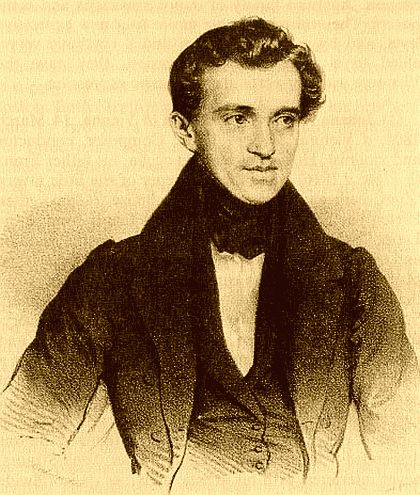
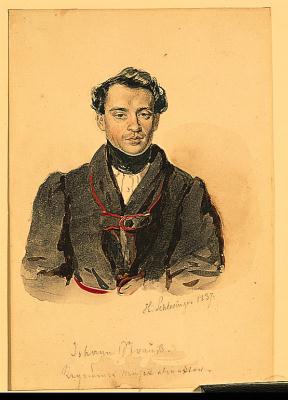
Johann Strauss I (March 14, 1804 – September 25, 1849; German: Johann Baptist Strauß, Johann Strauss (Vater); also Johann Baptist Strauss, Johann Strauss, Sr., the Elder, the Father), born in Vienna, was an Austrian Romantic composer famous for his waltzes, and for popularizing them alongside Joseph Lanner, thereby setting the foundations for his sons to carry on his musical dynasty. His most famous piece is probably the Radetzky March (named after Joseph Radetzky von Radetz), while his most famous waltz is probably the Lorelei Rheinklänge, Op. 154.
Johann Strauss was the father of Johann Strauss II, Josef Strauss and Eduard Strauss, the last of whom had a son called Johann Strauss III, born in 1866. He also had two daughters, Anna, who was born in 1829, and Therese, who was born in 1831. His youngest son, Ferdinand, born in 1834, lived only ten months. Strauss's parents, Franz Borgias Strauss (October 10, 1764 – April 5, 1816) and Barbara Dollmann (December 3, 1770 – August 28, 1811), were innkeepers (Zum heiligen Florian). Strauss had a Jewish grandfather, Johann Michael Strauss (1720 – 1800), who converted to Catholicism.
Tragedy struck his family as his mother died of 'creeping fever' when he was seven. When he was 12, his father Franz Borgias Strauss was discovered drowned, possibly by suicide, in the Danube river. His guardian, the tailor Anton Müller, placed him as an apprentice to a bookbinder Johann Lichtscheidl; Strauss took lessons in the violin and viola in addition to fulfilling his apprenticeship. Contrary to a story later told by his son, Johann jun., he never ran away from his bookbinder apprenticeship and in fact successfully completed it in 1822. He also studied music with Johann Polischansky during his apprenticeship and eventually managed to secure a place in a local orchestra of Michael Pamer which he eventually left in order to join a popular string quartet known as the Lanner Quartet formed by his would - be rival Joseph Lanner and the Drahanek brothers, Karl and Johann. This string quartet playing Viennese waltzes and rustic German dances expanded into a small string orchestra in 1824.
He eventually became deputy conductor of the orchestra to assist Lanner in commissions after it became so popular during the Fasching of 1824 and Strauss was soon placed in command of a second smaller orchestra which was formed as a result of the success of the parent orchestra. In 1825, he decided to form his own band and began to write music (chiefly, dance music) for it to play after he realized that he could also possibly emulate the success of Lanner in addition to putting an end to his financial struggles. By so doing, he would have made Lanner a serious rival although the rivalry did not entail hostile consequences as the musical competition was very productive for the development of the waltz as well as other dance music in Vienna. He soon became one of the best known and well loved dance composers in Vienna, and he toured with his band to Germany, the Netherlands, Belgium and Britain. The conducting reins and management of this 'Strauss Orchestra' would eventually be passed over to the hands of his sons variously until its disbandment by Eduard Strauss in 1901.
On a trip to France in 1837 he heard the quadrille and
began to compose them himself, becoming largely responsible for
introducing that dance to Austria in the 1840 Fasching, where it became
very popular. It was this very trip (in 1837) which has proved Strauss'
popularity with audiences from different social backgrounds and this
paved the way to forming an ambitious plan to perform his music in
England for the coronation of Queen Victoria in
1838. Strauss also adapted various popular melodies of his day into his
works so as to ensure a wider audience, as evidenced in the
incorporation of the Oberon overture into his early waltz, "Wiener Carneval", Op. 3, and also the French national anthem "La Marseillaise" into his "Paris - Walzer", Op. 101.
Strauss married Maria Anna Streim in 1825 in the parish church of Liechtenthal in Vienna. The marriage was relatively unhappy due to his prolonged absences caused by frequent tours abroad which led to a gradual alienation.
The family home was called 'Hirschenhaus' but was better known in Vienna as the 'Goldener Hirsch' (The Golden Stag). Strauss was a strict disciplinarian and demanded that none of his sons pursue careers in music, despite them displaying musical talent. Johann Junior was to study banking, likewise his brother Josef Strauss was destined for a military career, whereas the youngest Eduard Strauss was expected to join the Austrian consulate.
By 1834 Strauss had taken a mistress, Emilie Trampusch, with whom he had six children. When her husband openly acknowledged his paternity of a daughter born to Emilie in 1844, Maria Anna sued for divorce. With the ending of the marriage Anna Strauss determined to further Johann Strauss II's musical career, allowing him to develop his skills as a composer.
Despite
family problems, Strauss senior continued to tour frequently and was
always prepared to write novelty pieces for numerous charitable
organizations. His waltzes were gradually developed from a rustic
peasant dance into one which posterity would recognize as the Viennese Waltz.
They were written in three - quarter time with a short introduction;
often with little or no reference to the later chain of five two - part
waltz structure; usually appended with a short coda and concluded in a
stirring finish, although his son Johann Strauss II expanded the waltz
structure and utilized more instruments than his father. While he did
not possess a musical talent as rich as his eldest son's, nor a business
mind as astute, he was among the handful of early waltz composers along
with Joseph Lanner to actively write pieces with individual titles —
with the view to boost sales of their sheet music — which enabled music
enthusiasts to easily recognize those pieces. In fact, during his
performances at the Sperl - Ballroom in Vienna, where he established his
name, he actively pursued the concept of collecting a fixed entrance fee
from the patrons of the ballroom instead of the old practice of passing
around a collection plate where income was reliant on the goodwill of
the patrons.
Johann Strauss II often played his father's works and openly declared his admiration of them, although it was no secret to the Viennese that their rivalry was intense, with the press at that time fueling it. Johann Strauss I himself refused to play ever again at the Dommayer's Casino, which offered his son his conducting debut, and was to tower over his son during his lifetime in terms of career advancement, although Strauss II was to eclipse him in terms of popularity in the classical repertoire. In 1846, Johann Strauss I was awarded the honorary title of K.K. Hofballmusikdirektor (Director of Music for the Imperial and Royal Court Balls) by Emperor Ferdinand I.
Strauss died in Vienna in 1849 from scarlet fever contracted from one of his illegitimate children. He
was buried at the Döblinger cemetery beside his friend Joseph
Lanner. In 1904, both of their remains were transferred to the graves of
honor at the Zentralfriedhof. The former Döbling Cemetery is now a Strauss - Lanner Park. Hector Berlioz himself
paid tribute to the 'Father of the Viennese Waltz' by commenting that
'Vienna without Strauss is like Austria without the Danube'.
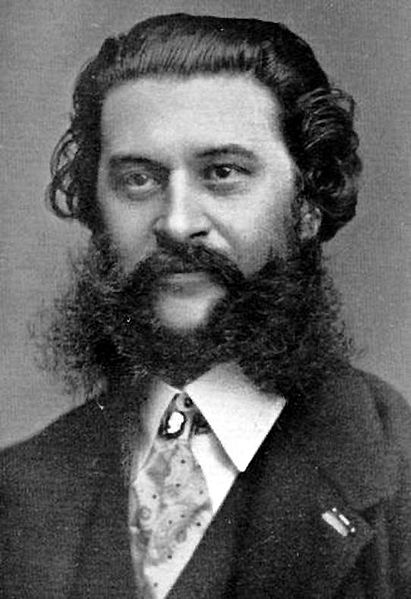
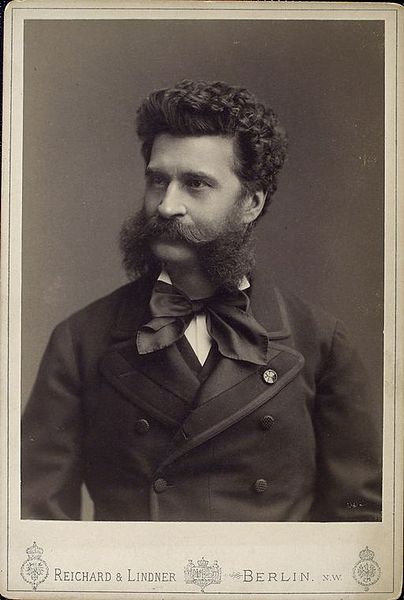
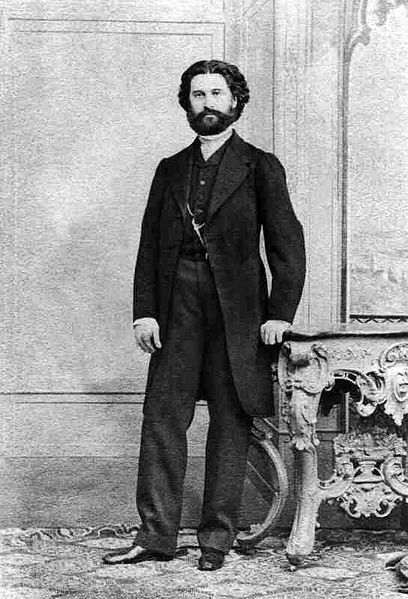
Johann Strauss II (October 25, 1825 – June 3, 1899), also known as Johann Baptist Strauss or Johann Strauss, Jr., the Younger, or the Son (Sohn), was an Austrian composer of light music, particularly dance music and operettas. He composed over 500 waltzes, polkas, quadrilles, and other types of dance music, as well as several operettas and a ballet. In his lifetime, he was known as "The Waltz King", and was largely then responsible for the popularity of the waltz in Vienna during the 19th century.
Strauss was born in St. Ulrich (now a part of Neubau), the son of Johann Strauss I, another composer of dance music. His father did not wish him to become a composer, but rather a banker; however, the son defied his father's wishes, and went on to study music with the composer Joseph Drechsler and the violin with Anton Kollmann, the ballet répétiteur of the Vienna Court Opera. Strauss had two younger brothers, Josef and Eduard Strauss, who became composers of light music as well, although they were never as well known as their elder brother.
Some of Johann Strauss's most famous works include The Blue Danube, Kaiser - Walzer, Tales from the Vienna Woods, the Tritsch - Tratsch - Polka, and the Pizzicato Polka. Among his operettas, Die Fledermaus and Der Zigeunerbaron are the best known.
Strauss was born in St. Ulrich near Vienna (now a part of Neubau), Austria, on October 25, 1825, to the famous composer Johann Strauss I. His father did not want him to become a musician but rather a banker; nevertheless, Strauss Junior studied the violin secretly as a child with the first violinist of his father's orchestra, Franz Amon. When his father discovered his son secretly practicing on a violin one day, he gave him a severe whipping, saying that he was going to beat the music out of the boy. It seems that rather than trying to avoid a Strauss rivalry, the elder Strauss only wanted his son to escape the rigors of a musician's life. It was only when the father abandoned his family for a mistress, Emilie Trampusch, that the son was able to concentrate fully on a career as a composer with the support of his mother.
Strauss studied counterpoint and harmony with theorist Professor Joachim Hoffmann, who
owned a private music school. His talents were also recognized by
composer Joseph Drechsler, who taught him exercises in harmony. His
other violin teacher, Anton Kollmann, who was the ballet
répétiteur of the Vienna Court Opera,
also wrote excellent testimonials for him. Armed with these, he
approached the Viennese authorities to apply for a license to perform. He initially formed his small orchestra where he recruited his members at the Zur Stadt Belgrad tavern, where musicians seeking work could be hired easily.
Johann Strauss I's influence over the local entertainment establishments meant that many of them were wary of offering the younger Strauss a contract for fear of angering the father. Strauss Jr. was able to persuade the Dommayer's Casino in Hietzing, a suburb of Vienna, to allow him to perform. The elder Strauss, in anger at his son's disobedience, and at that of the proprietor, refused to ever play at the Dommayer's Casino again, which had been the site of many of his earlier triumphs.
Strauss made his debut at Dommayer's in October 1844, where he performed some of his first works, such as the waltzes "Sinngedichte", Op. 1 and "Gunstwerber", Op. 4 and the polka "Herzenslust", Op. 3. Critics and the press were unanimous in their praise for Strauss's music. A critic for Der Wanderer commented
that "Strauss’s name will be worthily continued in his son; children
and children’s children can look forward to the future, and three - quarter time will find a strong footing in him."
Despite the initial fanfare, Strauss found his early years as a composer difficult, but he soon won over audiences after accepting commissions to perform away from home. The first major appointment for the young composer was his award of the honorary position of "Kapellmeister of the 2nd Vienna Citizen's Regiment", which had been left vacant following Joseph Lanner's death two years before.
Vienna was wracked by a bourgeois revolution on February 24, 1848, and the intense rivalry between father and son became much more apparent. Johann Jr. decided to side with the revolutionaries. It was a decision that was professionally disadvantageous, as the Austrian royalty twice denied him the much coveted 'KK Hofballmusikdirektor' position, which was first designated especially for Johann I in recognition of his musical contributions. Further, the younger Strauss was also arrested by the Viennese authorities for publicly playing "La Marseillaise", but was later acquitted. The elder Strauss remained loyal to the monarchy, and composed his "Radetzky March", Op. 228 (dedicated to the Habsburg field marshal Joseph Radetzky von Radetz), which would become one of his best known compositions.
When the elder Strauss died from scarlet fever in Vienna in 1849, the younger Strauss merged both their orchestras and engaged in further tours. Later, he also composed a number of patriotic marches dedicated to the Habsburg Emperor Franz Josef I,
such as the "Kaiser Franz - Josef Marsch" Op. 67 and the "Kaiser
Franz Josef Rettungs Jubel - Marsch" Op. 126, probably to ingratiate
himself in the eyes of the new monarch, who ascended to the Austrian
throne after the 1848 revolution.
Strauss Jr. eventually surpassed his father's fame, and became one of the most popular waltz composers of the era, extensively touring Austria – Hungary, Poland, and Germany with his orchestra. He applied for the KK Hofballmusikdirektor Music Director of the Royal Court Balls position, which he eventually attained in 1863, after being denied several times before for his frequent brushes with the local authorities.
In 1853, due to constant mental and physical demands, Strauss suffered a nervous breakdown. He took a seven week vacation in the countryside in the summer of that year, on the advice of doctors. Johann's younger brother Josef was persuaded by his family to abandon his career as an engineer and take command of Johann's orchestra in the interim.
In 1855, Strauss accepted commissions from the management of the Tsarskoye - Selo Railway Company of Saint Petersburg to play in Russia for the Vauxhall Pavilion at Pavlovsk in 1856. He would return to perform in Russia every year until 1865.
Later,
in the 1870s, Strauss and his orchestra toured the United States, where
he took part in the Boston Festival at the invitation of bandmaster Patrick Gilmore and was the lead conductor in a 'Monster Concert' of over 1000 performers, performing his "Blue Danube" waltz, amongst other pieces, to great acclaim.
Strauss married the singer Jetty Treffz in 1862, and they remained together until Jetty's death in 1878. Six weeks after her death, Strauss married the actress Angelika Dittrich. Angelika was not a fervent supporter of his music, and their differences in status and opinion, and especially her indiscretion, led him to seek a divorce.
Strauss
was not granted a divorce by the Roman Catholic Church, and therefore
changed religion and nationality, and became a citizen of Saxe - Coburg - Gotha in January 1887. Strauss
sought solace in his third wife Adele Deutsch, whom he married in
August 1882. She encouraged his creative talent to flow once more in his
later years, resulting in many famous compositions, such as the operettas Der Zigeunerbaron and Waldmeister, and the waltzes "Kaiser - Walzer" Op. 437, "Kaiser Jubiläum" Op. 434, and "Klug Gretelein" Op. 462.
Although Strauss was the most sought after composer of dance music in the latter half of the 19th century, stiff competition was present in the form of Karl Michael Ziehrer and Émile Waldteufel; the latter held a commanding position in Paris. Phillip Fahrbach also denied the younger Strauss the commanding position of the KK Hofballmusikdirektor when the latter first applied for the post. The German operetta composer Jacques Offenbach, who made his name in Paris, also posed a challenge to Strauss in the operetta field.
Strauss was admired by other prominent composers: Richard Wagner once admitted that he liked the waltz "Wein, Weib und Gesang" Op. 333. Richard Strauss (unrelated to the Strauss family), when writing his Rosenkavalier waltzes, said in reference to Johann Strauss, "How could I forget the laughing genius of Vienna?"
Johannes Brahms was a personal friend of Strauss; the latter dedicated his waltz "Seid umschlungen, Millionen!" ("Be Embraced, You Millions!"), Op. 443, to him. A story is told in biographies of both men that Strauss's wife Adele approached Brahms with a customary request that he autograph her fan. It was usual for the composer to inscribe a few measures of his best known music, and then sign his name. Brahms, however, inscribed a few measures from the "Blue Danube", and then wrote beneath it: "Unfortunately, NOT by Johannes Brahms."
The most famous of Strauss' operettas are Die Fledermaus, Eine Nacht in Venedig, and Der Zigeunerbaron.
Notwithstanding their general lack of modern popularity, there are many
dance pieces drawn from themes of his operettas, such as
"Cagliostro - Walzer" Op. 370 (from Cagliostro in Wien), "O Schöner Mai" Walzer Op. 375 (from Prinz Methusalem), "Rosen aus dem Süden" Walzer Op. 388 (from Das Spitzentuch der Königin), and "Kuss - Walzer" op. 400 (from Der lustige Krieg), that have survived obscurity and become well known. Strauss also wrote an opera, Ritter Pázmán, and was in the middle of composing a ballet, Aschenbrödel, when he died in 1899.
Strauss was diagnosed with pleural pneumonia in the spring of 1899, and died in Vienna, at the age of 73. He was buried in the Zentralfriedhof. At the time of his death, he was still composing his ballet Aschenbrödel.
Strauss's music is now regularly performed at the annual Neujahrskonzert of the Vienna Philharmonic Orchestra, as a result of the efforts by Clemens Krauss who performed a special all - Strauss program in 1929 with the Viennese orchestra. Many distinguished Strauss interpreters include Willi Boskovsky, who carried on the "Vorgeiger" tradition of conducting with violin in hand, as is the Strauss family custom, as well as Herbert von Karajan and the opera conductor Riccardo Muti. In addition, the Wiener Johann Strauss Orchester, which was formed in 1966, pays tribute to the touring orchestras which once made the Strauss family so famous.
Most of the Strauss works that are performed today may once have existed in a slightly different form, as Eduard Strauss destroyed much of the original Strauss orchestral archives in a furnace factory in Vienna's Mariahilf district in 1907. Eduard,
then the only surviving brother of the three, took this drastic
precaution after agreeing to a pact between himself and brother Josef
that whoever outlived the other was to destroy their works. The measure
was intended to prevent the Strauss family's works from being claimed by
another composer. This may also have been fueled by Strauss's rivalry
with another of Vienna's popular waltz and march composers, Karl Michael Ziehrer.
The lives of the Strauss dynasty members and their world renowned craft of composing Viennese waltzes are also briefly documented in several television adaptations, such as The Strauss Family (1972), The Strauss Dynasty (1991) and Strauss, the King of 3/4 Time (1995). Many other films used his works and melodies, and several films have been based upon the life of the musician, the most famous of which is called The Great Waltz (1938). Alfred Hitchcock made a low budget biographical film of Strauss in 1933 called Waltzes from Vienna. After a trip to Vienna, Walt Disney was inspired to create four feature films. One of those was The Waltz King, a loosely adapted biopic of Johann Strauss, which aired as part of the Wonderful World of Disney in the U.S. in 1963. In Mikhail Bulgakov's 1940 (published 1967) novel, The Master and Margarita, Johann Strauss conducts the orchestra during Satan's Great Ball at the invitation of Behemoth.
A Corny Concerto (1943), a Warner Bros cartoon, directed by Bob Clampett with animation by Robert McKimson, features music that was composed by Johann Strauss, and is a parody of Walt Disney's 1940 Fantasia. The cartoon is narrated by Elmer Fudd, parodying Deems Taylor's appearance in Fantasia.
The 1953 animated short "Johann Mouse" from the series Tom and Jerry features a mouse mesmerized by the playing of several Strauss waltzes by the cat.